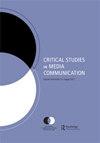Black monstrosity and the rhetoric of whiteness in Disney’s Zombies trilogy
IF 1.5
2区 文学
Q3 COMMUNICATION
引用次数: 0
Abstract
ABSTRACT Drawing from strategic whiteness and guided by racial rhetorical criticism, this article analyzes Disney’s Zombies movie trilogy. Situated within the context of anti-Critical Race Theory policies and the use of children and K-12 education as political pawns, the timely release of Zombies as a postracial narrative motivates this research. Through the positioning of humans, zombies, werewolves, and aliens as fixed symbolic racial groups within the imagined utopian United States town of Seabrook, Zombies presents an ideology of diversity, equity, and inclusion (DEI) that sustains white power and fluidity. This rhetorical analysis presents three conclusions. First, the imaginary utopian town of Seabrook is a postracial space developed around stereotypical racialized characters and narratives that contribute to the historical marginalization of Indigenous, Asian American and Pacific Islander (AAPI), and Black people. Second, through the protagonist Zed and the cinematic construction of zombies, the trilogy perpetuates a postracial anti-Blackness via the inscription of a policed and controlled monstrosity onto Black identity. Third, the second protagonist, Addison, engages in the propagation of whiteness via voyeuristic racial tourism and white purity. In total, the children’s mediated narrative upholds white centrality and power obviated by contemporary DEI discourses and representations.迪士尼僵尸三部曲中的黑色怪物和白色修辞
本文以战略白人为背景,以种族修辞批评为指导,对迪士尼的《僵尸三部曲》电影进行分析。在反批判种族理论政策和将儿童和K-12教育作为政治棋子的背景下,《僵尸》作为一种后现代叙事的及时发布激发了这项研究。通过将人类、僵尸、狼人和外星人定位为想象中的乌托邦式美国小镇西布鲁克中固定的象征性种族群体,《僵尸》呈现了一种多样性、公平和包容(DEI)的意识形态,这种意识形态维持了白人的权力和流动性。这一修辞分析得出了三个结论。首先,虚构的乌托邦小镇西布鲁克是一个后种族空间,围绕着刻板的种族化角色和叙事发展而来,这些角色和叙事导致了土著、亚裔美国人和太平洋岛民(AAPI)以及黑人的历史边缘化。其次,通过主角Zed和僵尸的电影构造,三部曲通过将一个被警察和控制的怪物铭刻在黑人身份上,延续了一种后种族的反黑人性。第三,第二个主人公艾迪生通过偷窥性的种族旅游和白人纯洁性来传播白人。总的来说,儿童的中介叙事维护了当代DEI话语和表现所避免的白人中心地位和权力。
本文章由计算机程序翻译,如有差异,请以英文原文为准。
求助全文
约1分钟内获得全文
求助全文
来源期刊

Critical Studies in Media Communication
COMMUNICATION-
CiteScore
2.10
自引率
0.00%
发文量
34
期刊介绍:
Critical Studies in Media Communication (CSMC) is a peer-reviewed publication of the National Communication Association. CSMC publishes original scholarship in mediated and mass communication from a cultural studies and/or critical perspective. It particularly welcomes submissions that enrich debates among various critical traditions, methodological and analytical approaches, and theoretical standpoints. CSMC takes an inclusive view of media and welcomes scholarship on topics such as • media audiences • representations • institutions • digital technologies • social media • gaming • professional practices and ethics • production studies • media history • political economy. CSMC publishes scholarship about media audiences, representations, institutions, technologies, and professional practices. It includes work in history, political economy, critical philosophy, race and feminist theorizing, rhetorical and media criticism, and literary theory. It takes an inclusive view of media, including newspapers, magazines and other forms of print, cable, radio, television, film, and new media technologies such as the Internet.
 求助内容:
求助内容: 应助结果提醒方式:
应助结果提醒方式:


